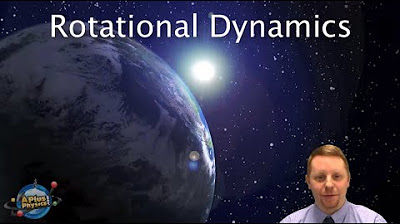More on moment of inertia | Moments, torque, and angular momentum | Physics | Khan Academy
TLDRThe video script delves into the concept of moment of inertia, emphasizing its significance in determining an object's resistance to angular acceleration. It explains that moment of inertia is intrinsic to rotational inertia and is pivotal in Newton's second law of motion in its angular form. The script clarifies that moment of inertia varies with the distribution of mass relative to the axis of rotation, using examples of point masses, rods, cylinders, and spheres to illustrate different calculation formulas. It highlights how moving mass closer to the axis or reducing mass can decrease moment of inertia, making rotation easier. The use of calculus for continuous objects is mentioned, with specific formulas provided for various geometries and axes of rotation.
Takeaways
- 🌟 The moment of inertia is a measure of an object's resistance to angular acceleration, representing its rotational inertia.
- 📐 The formula for moment of inertia for a point mass is given by I = mr², where m is the mass and r is the distance from the axis of rotation.
- 🔄 For multiple point masses, the total moment of inertia is the sum of the individual moments of inertia (I = m₁r₁² + m₂r₂² + ... + mₙrₙ²).
- 🎾 The moment of inertia can be reduced by moving the mass closer to the axis of rotation, making the object easier to rotate.
- 🏌️ For extended objects like rods or cylinders, calculus is used to determine the moment of inertia, which differs from the point mass formula.
- 🔧 The moment of inertia for a rod rotating about its end is I = (1/3)mL², and for rotation about its center, it's I = (1/12)mL².
- 🔄 For a cylinder rotating about its center, the moment of inertia is I = (1/2)mr², where m is the mass and r is the radius.
- 🌐 For a sphere rotating about an axis through its center, the moment of inertia is I = (2/5)mr².
- 📈 The distribution of mass within an object affects its moment of inertia; objects with mass distributed closer to the axis of rotation have a lower moment of inertia.
- 📚 The axis of rotation is a critical factor in determining the moment of inertia; different axes yield different values.
- 🔍 Reference materials such as textbooks or online resources often provide charts listing the moments of inertia for various objects and their respective axes.
Q & A
What is the moment of inertia in physics?
-The moment of inertia, also known as rotational inertia, is a measure of an object's resistance to angular acceleration. It indicates how difficult it is to speed up or slow down an object's rotation.
How does the moment of inertia relate to Newton's second law in rotational motion?
-In the angular version of Newton's second law, the angular acceleration is equal to the net torque divided by the moment of inertia. This highlights the role of moment of inertia as the rotational counterpart to mass in linear motion.
What is the formula for the moment of inertia of a point mass in circular motion?
-The moment of inertia for a point mass in circular motion is given by the formula mr^2, where m is the mass and r is the distance from the axis of rotation.
How do you calculate the moment of inertia for a system with multiple point masses?
-For a system with multiple point masses, you can calculate the total moment of inertia by summing the contributions from each individual point mass using the formula mr^2 for each mass and its respective distance from the axis.
How does the position of mass affect the moment of inertia?
-The position of mass greatly affects the moment of inertia. If masses are moved closer to the axis of rotation, the moment of inertia decreases, making the object easier to rotate. Conversely, moving masses away from the axis increases the moment of inertia.
What is the moment of inertia for a rod rotating about its end?
-The moment of inertia for a rod rotating about its end is given by the formula (1/3) mL^2, where m is the total mass of the rod and L is its length.
How does rotating an object about its center change its moment of inertia compared to rotating about its end?
-Rotating an object about its center typically results in a lower moment of inertia compared to rotating about its end. This is because more mass is closer to the axis of rotation when the object is rotated about its center, leading to smaller radii and thus a lower moment of inertia.
What is the moment of inertia for a cylinder rotating about its center?
-The moment of inertia for a cylinder rotating about its center is given by the formula (1/2) mr^2, where m is the mass and r is the radius of the cylinder.
How does the shape of an object affect its moment of inertia?
-The shape of an object affects its moment of inertia because different shapes have different mass distributions relative to the axis of rotation. For example, a sphere has a moment of inertia of (2/5) mr^2 when rotating about its center, which is different from the formulas for rods, cylinders, and point masses.
What is the moment of inertia for a sphere rotating about its center?
-The moment of inertia for a sphere rotating about its center is given by the formula (2/5) mr^2, where m is the mass and r is the radius of the sphere.
Why do continuous objects like rods, cylinders, and spheres have moments of inertia less than mL^2 or mr^2?
-Continuous objects have moments of inertia less than mL^2 or mr^2 because not all mass is rotating at the maximum radius. Some mass is closer to the axis of rotation, resulting in smaller radii and reduced contributions to the overall moment of inertia.
Outlines
🌟 Understanding Moment of Inertia
This paragraph introduces the concept of moment of inertia, highlighting its significance in determining the resistance of an object to angular acceleration. It explains that a larger moment of inertia makes an object more resistant to changes in its rotational speed, while a smaller one indicates ease of angular acceleration. The paragraph also discusses the relevance of moment of inertia in Newton's second law for angular motion, where it is the denominator in the formula for angular acceleration (alpha). The analogy of a point mass is used to simplify the calculation of moment of inertia, emphasizing that it can be treated as if all the mass is concentrated at a certain distance from the axis of rotation. The formula for calculating moment of inertia for a point mass in circular motion is presented as mass times the square of the distance from the axis.
🔄 Calculating Moment of Inertia for Distributed Masses
The second paragraph delves into the calculation of moment of inertia for systems with multiple point masses. It explains that the total moment of inertia is the sum of the individual moments of inertia for each point mass, using the formula m times r squared. The paragraph uses an example of three point masses to illustrate how to calculate the total moment of inertia by adding up the contributions from each mass. It also discusses the impact of mass distribution on the ease of rotation, suggesting that moving masses closer to the axis of rotation reduces the moment of inertia, making the system easier to rotate. The example of a baseball bat is used to illustrate this concept, showing that swinging the bat from the end where the mass is concentrated near the axis results in less moment of inertia and easier rotation.
📐 Moment of Inertia for Continuous Objects
This paragraph addresses the challenge of calculating the moment of inertia for continuous objects, such as a rod or a cylinder, where mass is distributed throughout the object. It explains that the formulas for point masses cannot be applied and instead, calculus is required to derive the moment of inertia for these shapes. The paragraph provides the results for the moment of inertia for a rod rotating about its end (1/3 mL squared) and about its center (1/12 mL squared), and for a cylinder rotating about its center (1/2 mr squared). It also discusses the impact of the axis of rotation on the moment of inertia, emphasizing that the location of the axis significantly affects the calculation. The paragraph concludes with the formula for the moment of inertia of a sphere rotating about an axis through its center, which is 2/5 mr squared. The key takeaway is that the distribution of mass within an object affects its moment of inertia, with mass closer to the axis contributing less to the total inertia.
Mindmap
Keywords
💡Moment of Inertia
💡Angular Acceleration
💡Net Torque
💡Point Mass
💡Rotational Inertia
💡Newton's Second Law (Angular Version)
💡Rod
💡Cylinder
💡Sphere
💡Calculus
💡Axis of Rotation
Highlights
The moment of inertia is also known as rotational inertia, which represents the resistance to angular acceleration.
An object with a large moment of inertia will be difficult to angularly accelerate, whereas an object with a small moment of inertia will be easier to angularly accelerate.
The moment of inertia is a factor in the angular version of Newton's second law, where angular acceleration is equal to the net torque divided by the moment of inertia.
The moment of inertia for a point mass is calculated as mass times the square of the distance from the axis.
For multiple point masses, the moment of inertia is the sum of the contributions from each individual point mass.
The moment of inertia can be reduced by moving masses closer to the axis of rotation, making the object easier to rotate.
The moment of inertia for a rod rotating about its end is 1/3 mL squared.
For a rod rotating about its center, the moment of inertia is 1/12 mL squared.
The moment of inertia for a cylinder (or disc) rotating about its center is 1/2 mr squared.
A sphere rotating about an axis through its center has a moment of inertia of 2/5 mr squared.
The distribution of mass within an object affects its moment of inertia, with mass closer to the axis contributing less to the inertia.
The moment of inertia depends on the axis of rotation, with different formulas for different geometries and axis locations.
Calculus, specifically integrals, is used to derive the formulas for the moment of inertia of continuous objects.
The moment of inertia is crucial in determining the ease or difficulty of rotating an object.
Practical applications of moment of inertia can be seen in everyday objects like baseball bats, where holding closer to the axis allows for faster rotation.
The moment of inertia is a fundamental concept in physics, with wide applications in understanding the dynamics of rotating systems.
For complex geometries, charts with moments of inertia for commonly-shaped objects and their respective axes can be found in textbooks or online.
Transcripts
Browse More Related Video

Moment of Inertia | Physics with Professor Matt Anderson | M12-05

College Physics 1: Lecture 25 - Moment of Inertia and Rotational Dynamics

AP Physics 1 - Rotational Dynamics

Rotational version of Newton's second law | Physics | Khan Academy

Inertia - Basic Introduction, Torque, Angular Acceleration, Newton's Second Law, Rotational Motion

Demonstrating Rotational Inertia (or Moment of Inertia)
5.0 / 5 (0 votes)
Thanks for rating: